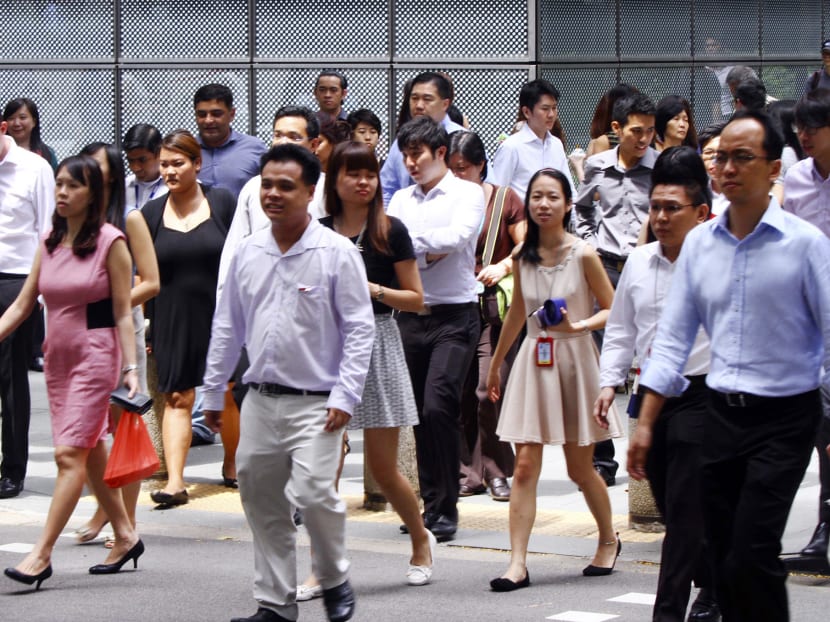Singapore to be hardest hit in Asia by fall in working population growth: Report
SINGAPORE — While Japan had the biggest slump in its workforce in Asia over the last 10 years, Singapore has the most to fear from an ageing population over the next two decades, based on projections by an international research house.
SINGAPORE — While Japan had the biggest slump in its workforce in Asia over the last 10 years, Singapore has the most to fear from an ageing population over the next two decades, based on projections by an international research house.
As a result of a shrinking workforce and slower progress than Asian neighbours in getting more people into the labour market, the Republic is expected to face a "massive decline" in its working age population growth by 2036, "in part because of less immigration after a recent policy shift", said the report, which was published on Monday (Sept 4) by Oxford Economics.
The report noted that several economies such as China, South Korea, Taiwan and Hong Kong have already felt the impact of demographic changes over the past decade, "and adjusted and responded to them, to varying degrees".
In contrast, Singapore posted a "whopping" 2.4-per-cent growth in its working-age population on average annually between 2007 and last year. As a result, it could be the hardest hit in the next 20 years: Compared to the previous decade, Singapore's labour supply growth - after accounting for projected changes to the participation rate - will shrink by 1.7 percentage points yearly between this year and 2026, and by 2.5 percentage points annually in the subsequent decade. This would be the worst among 12 economies covered in the report, which was written by Mr Louis Kuijs, who heads the Asia Economics team at Oxford Economics. The report estimated that a 1 percentage point decline in labour supply growth would shave off a half-point to two-thirds of a percentage point in gross domestic product growth.
Commenting on the report, economists interviewed by TODAY said it showed a "stark reality" of an issue that the Singapore Government has been trying to address for some years now, through measures such as encouraging automation and raising the re-employment age. Nevertheless, they stressed that there was no need for alarm, as Singapore's policymakers are aware of the shrinking workforce and the repercussions, and are "actively pursuing interventions", as labour economist Randolph Tan put it.
Assoc Prof Tan, who is from the Singapore University of Social Sciences (SUSS), noted that the report presented only "one of several plausible scenarios". "Even though I believe the forecasts are useful as a warning of how bad things can get, there are several things we can do to produce a much better outcome. (For instance), Singapore can take advantage of our size instead of being constrained by it…and re-model ourselves to allow a small workforce to work smarter and more effectively," he said.
The decline in Malaysia, Hong Kong and China will be less than 0.4 percentage point yearly between 2017 and 2026, and less than 1 percentage point a year in the subsequent decade. While Japan's economic growth has been hit by demographic challenges in recent decades, the country's rising labour force participation will help ease its labour crunch in the next 10 years, with growth expected to pick up by 0.9 percentage point yearly. Rising participation is also expected to offset the decline in the working population in Indonesia, India and the Philippines. Along with Singapore, Taiwan and South Korea are the economies that would be "worst affected", the report said.
Speaking to TODAY, Mr Kuijs suggested that the Republic continue to explore ways of making work more attractive for seniors and women, such as ensuring that day-care facilities are widely available within or near to workplaces.
The Government's Population White Paper, which was published in January 2013, warned of a shrinking labour force. The paper projected the old-age support ratio - which is the number of working-age citizens for each citizen aged 65 and above - to fall to 2.1 by 2030, from 5.9 in 2012. A "smaller, less energetic workforce" would dampen business activity, and cause job and employment opportunities to shrink, it said.
In recent years, Manpower Minister Lim Swee Say has also stressed that the labour market here will remain tight, and unless Singapore can get the most out of its manpower, it would become a major bottleneck of growth in the future.
After years of surging foreign manpower growth, the Government has - since 2011 - moved to tighten the inflow of immigrants in its bid to reduce reliance on low-cost foreign labour.
The Government has made clear on several occasions that it will not perform a U-turn on its stance. Still, some of the analysts felt it may be time to re-look these policies, but they cautioned that it must be done in a "politically sensitive manner". CIMB Private Banking economist Song Seng Wun said: "We must ensure that there is enough room and infrastructure to support immigration before turning up the foreign labour tap."
SUSS economist Walter Theseira pointed out that without immigration, the natural rate of population growth in Singapore is "effectively zero". "However, the timing and extent of such a shift depends very much on both infrastructure and political acceptability of immigration," he said.
Technology has been touted a key to solving the labour crunch, with the Government heavily investing in measures to encourage automation and better use of technology across various industries.
Dr Theseira said: "For example, if autonomous vehicles were widespread, we would have tens of thousands of taxi and private hire drivers… who would be looking for employment… While the total labour supply wouldn't change, getting them interested in other jobs could really boost effective labour supply."







